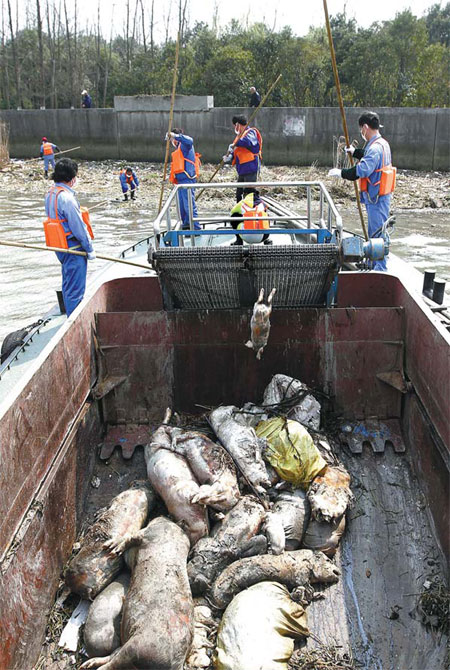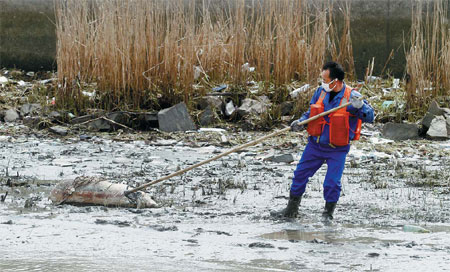Floating carcasses prompt safety concerns
Updated: 2013-03-20 07:16
By Wang Hongyi in Jiaxing and He Na and Xu Wei in Beijing (China Daily)
|
||||||||
|
Above and below: Sanitation workers retrieve dead pigs from the Huangpu River in Shanghai. A large number of carcasses have been discovered floating in the Huangpu River and rivers and lakes in neighboring Jiaxing city. Photos by Xing Kong / for China Daily |

The discovery of a huge number of dead pigs floating in rivers, lakes and streams in the area around Shanghai has once again put China's livestock and food industries in the spotlight. Report by Wang Hongyi in Jiaxing and He Na and Xu Wei in Beijing
Zhulin village in Jiaxing city, Zhejiang province, is one of China's largest pig-breeding centers. As you drive along the road towards the village, the air reeks of pig feed and the smell of manure becomes overwhelming. The residents joke that if they close their eyes while traveling by train, they never miss their station simply because the smell tells them exactly where they are.
The ochre-colored, two-story houses are scattered across the village, and compared with the noise on the road, the place is quiet, except for the squeals of the pigs.
Despite its status as a center of pork production, the village was largely unknown to the outside world until early March, when it gained national notoriety.
Zhulin became a household name after reports on March 5 that huge numbers of pig carcasses, an abnormally high proportion of them piglets, had been discovered floating in the waters of Shanghai's Huangpu River and rivers and lakes in neighboring Jiaxing.
In the past few days, around 9,500 carcasses have been fished out of the Huangpu River - which supplies 22 percent of Shanghai's tap water - according to the Shanghai Municipal Government. Media reports have put the number of carcasses in the region at 13,000.
And that number keeps rising, albeit slowly, even as the clean up operation continues. The authorities said tests have revealed no abnormalities in the water quality in either Shanghai or Jiaxing, or in the pork on sale in local shops and markets.
Information found stamped on, or cut into, the pigs' ears prompted the authorities in Shanghai to pinpoint Jiaxing as the source of the carcasses, a claim denied by the town government. In response, it published a newsletter in which it argued that as a major producer the city attaches great importance to the correct disposal of carcasses.
However, even Yu Kangzhen, chief veterinarian with the Ministry of Agriculture who led a team to investigate the case, has been unable to accurately locate the source. According to Xinhua News Agency, Yu said tests carried out on the pigs ruled out the possibility of any epidemic affecting swine in Jiaxing, and he attributed the high number of deaths to common infections caused by the changeable weather.
The large number of small piggeries in Jiaxing mean it's common to see dead swine in the farmyards and abattoirs. However, if the animals have died of disease, the local farmers will often dump the carcasses in rivers or on rural roads, Yu added.
Disposal
China is the world's largest consumer and producer of pork. The country accounted for almost 50 percent of global production in 2011, according to the United States Department of Agriculture.
Approximately 130,000 households raised more than 7 million pigs in Jiaxing last year, 89 percent of them coming from small farms, capable of raising fewer than 50 pigs each.
Although evidence that the carcasses originated in Jiaxing is still sketchy, the problems arising from pig breeding and the disposal of dead animals mean the town has inevitably been in the spotlight.
"While it's wrong for people to dump carcasses in the river, it's almost inevitable, given that the disposal of so many dead pigs requires land and investment, which are usually beyond the capacity of individual farmers. However, the government mechanism to compensate farmers or solve the problem is inadequate," said Feng Yonghui, general manager of the online pig industry researcher Soozhu.
China Business News quoted a Zhulin resident who said villagers throw out dead pigs just like they throw out garbage. Conscientious farmers transfer the carcasses to assigned disposal points, but the rest dump the bodies wherever it's convenient.
Huang Jun, vice-head of Xinfeng township, which administers Zhulin village, said the town established a system to oversee the collection of dead pigs in 2009. So far, 112 collection points have been set up and others will follow.
"Villagers are required to hand the pigs over at the collection points or wait for government workers to come and collect them. But some individuals still throw pigs into the water. We have to continue educating them and tell them about the environmental damage caused by throwing dead animals into the river," he said.
Following the discovery of the carcasses, the local authorities tightened the regulations on dumping. "People who dispose of carcasses illegally will be fined 2,000 yuan ($322) and detained for seven days," said Huang.
Feng said farmers are generally unwilling to inform the authorities about a large number of deaths caused by disease because the ineffectual compensation system often results in big losses. "In many cases, the dead pigs are sold on the markets without being inspected by the authorities," he said.
Compensation
Pig farmers and slaughterhouses are eligible for compensation of 500 yuan for each sick pig that dies, while slaughterhouses that dispose of carcasses receive 80 yuan per pig.
However, even such a relatively modest amount cannot usually be afforded by local governments, which generally do not include funds for the disposal of dead pigs and other livestock in their budgets. The central government provides only a limited amount of the total compensation, leaving the local authorities to cover the shortfall, which they are often unable to do.
Peng Li, a veterinarian at the animal veterinary station in Nanzheng county, Shaanxi province, said poor compensation is one of the main reasons why farmers either dump carcasses or illegally sell the bodies of pigs that have died of disease.
She added that even when farmers try to dispose of carcasses in the approved fashion, the process is not standardized and can still cause pollution. "When a large number of pigs die, the usual practice of burying them is impractical because of a shortage of usable land in the rural areas," she said.
Meanwhile, small farmers' lack of awareness about methods of disease prevention is another problem.
"When a small number of piglets die, they are just thrown away. But when they die in large numbers, illegal slaughterhouses collect the bodies at a low price. Some of the meat is used to make fillings for dumplings," said Zhang Qiang, who has switched from running a small farm in Wulian county, Shandong province, to a much larger operation of more than 1,000 pigs. He said he had never heard of any sort of local authority compensation.
Method
Xinfeng town still uses the traditional method of carcass disposal. The bodies decompose slowly in large holding tanks containing corrosive chemicals. However, the time-consuming nature of the process means it's hard to meet the demand caused by the large number of carcasses every year.
Shanghai's animal incineration center was introduced in 2003. Its daily capacity of 35 cubic tons is equal to that of Xinfeng's 40 disposal tanks working at full capacity for six months.
The methods employed in Shanghai are better regulated, but the initial outlay is far higher than that for disposal tanks. However, the traditional method is also costly; the tanks require far more land than an incinerator and the process can cause secondary pollution and safety hazards, according to Chen Xiang, a researcher at the Office of the Agriculture and Rural Affairs Committee of the Zhejiang Provincial People's Congress.
China's rapid urbanization has also added to the problem; many pig farms have been driven to the suburbs because of land shortages and concerns about pollution. "Pig breeding requires land, and the smell is also very unappealing to nearby residents. Therefore, communities do not want pigsties near them," said Feng.
"Faced with soaring land prices, the farmers are forced to increase the density of piglets on their farms, which increases the risk of disease," he said.
"I've been raising pigs for more than six years. Generally, each pig needs at least 1 cubic meter of space. If that space is too crowded, the temperature and humidity of the farm is affected. It also causes changes in the way the pigs eat and drink, their levels of activity and rest. Drainage also becomes a bigger problem," said Wang Honglai, a farmer from Wangzhuangtou village in Cangzhou, Hebei province.
"I've never seen a large number of pig deaths in our village, but I know that farmers secretly sell fully grown dead pigs to slaughterhouses at a very low price. If piglets too young for the table die, the farmers just throw them away," he said.
Insufficient government spending has resulted in a lack of administrative power in the supervision of the livestock industry, and the large number of individual breeders means it has become a problem nationwide.
"Supervision of the pork industry requires the combined efforts of several government departments, such as the agriculture, commerce, food and drug administrations, and the complicated process often results in departments evading their responsibilities," said Peng.
The method of evaluating government officials also discourages them from reporting outbreaks of disease to their superiors, according to Feng. "The general health of the pigs is an important evaluation standard for officials. If an epidemic occurs in a certain region, high-level officials are likely to question whether the preventive work has been done. Fearing a negative effect, many officials choose to hide outbreaks, rather than report them," he said.
To make matters worse, the huge number of small-scale farmers makes it difficult for insurance companies to gather evidence if disease strikes. That, plus the high failure rate, means insurers are unwilling to provide cover, according to Zhang.
He added that even if cover were available, few farmers could afford to pay premiums that can be as high as 100 yuan per animal, especially as the risk of failure is so high. "Even if the pigs have been given a large number of vaccines, diseases are not always avoidable because of the wide range of different strains. It's an unavoidable fact."
Yang Wanli contributed to this story.
Contact the writers at wanghongyi@chinadaily.com.cn and hena@chinadaily.com.cn
(China Daily 03/20/2013 page6)

 In Photos: 7.0-magnitude quake hits Sichuan
In Photos: 7.0-magnitude quake hits Sichuan
 Li Na on Time cover, makes influential 100 list
Li Na on Time cover, makes influential 100 list
 FBI releases photos of 2 Boston bombings suspects
FBI releases photos of 2 Boston bombings suspects
 World's wackiest hairstyles
World's wackiest hairstyles
 Sandstorms strike Northwest China
Sandstorms strike Northwest China
 Never-seen photos of Madonna on display
Never-seen photos of Madonna on display
 H7N9 outbreak linked to waterfowl migration
H7N9 outbreak linked to waterfowl migration
 Dozens feared dead in Texas plant blast
Dozens feared dead in Texas plant blast
Most Viewed
Editor's Picks

|

|

|

|

|

|
Today's Top News
Live report: 7.0-magnitude quake hits Sichuan, heavy casualties feared
Boston suspect cornered on boat
Cross-talk artist helps to spread the word
'Green' awareness levels drop in Beijing
Palace Museum spruces up
First couple on Time's list of most influential
H7N9 flu transmission studied
Trading channels 'need to broaden'
US Weekly

|

|








